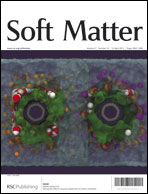The influence of the chain degree of ionization on the adsorption of weak polyelectrolytes on neutral and on oppositely and likely charged surfaces is investigated, by means of Monte Carlo simulations with a mesoscopic interaction model known as dissipative particle dynamics. The electrostatic interactions are calculated using the three-dimensional Ewald sum method, with an appropriate modification for confined systems. Effective wall forces confine the linear polyelectrolytes, and electric charges on the surfaces are included. The solvent, which is included explicitly, has a fluctuating particle number. The results show that the polyelectrolytes adsorb onto both neutral and charged surfaces, with the adsorption regulated by the chain degree of ionization, being larger at lower ionization degrees, where polyelectrolytes are less charged. Furthermore, polyelectrolyte adsorption is strongly modulated by the counterions screening of surface charges. These findings are supported by predictions of adsorption isotherms with varying ionization degrees. We obtain also the surface force mediated by adsorbed polyelectrolytes, which is calculated for the first time as a function of ionization degree. The adsorption and surface force isotherms obtained for weak polyelectrolytes are found to reproduce main trends in experiments, whenever those results are available, and provide additional insight into the role played by the competitive adsorption of the counterions and polyelectrolytes on the surfaces.

You have access to this article
 Please wait while we load your content...
Something went wrong. Try again?
Please wait while we load your content...
Something went wrong. Try again?


 Please wait while we load your content...
Please wait while we load your content...